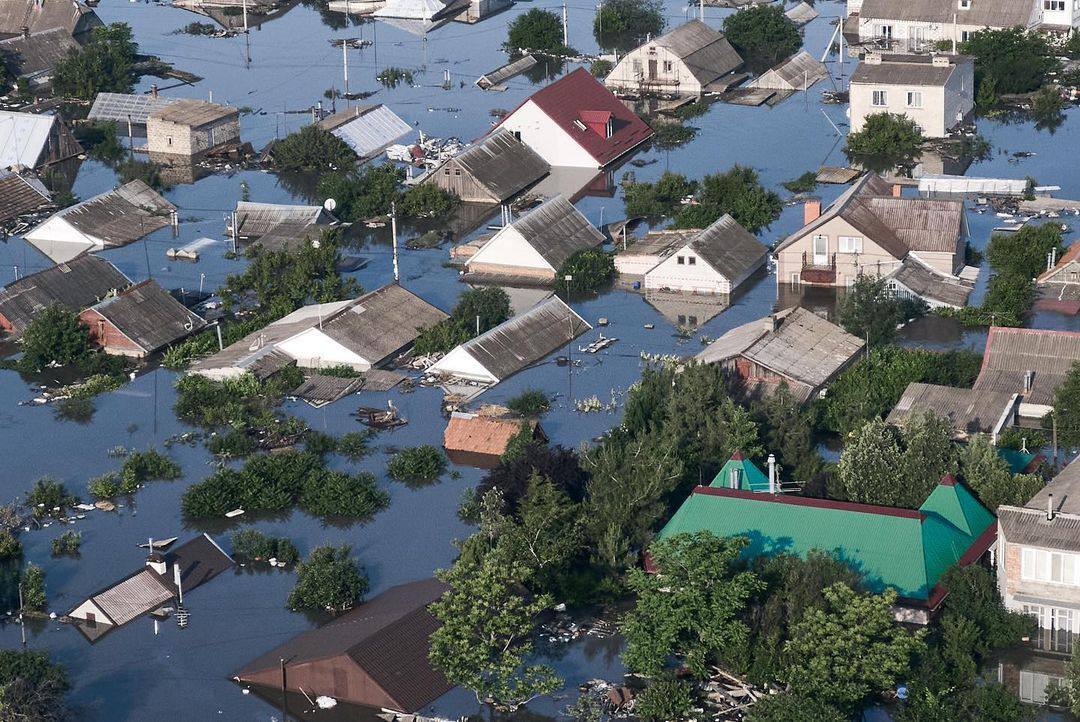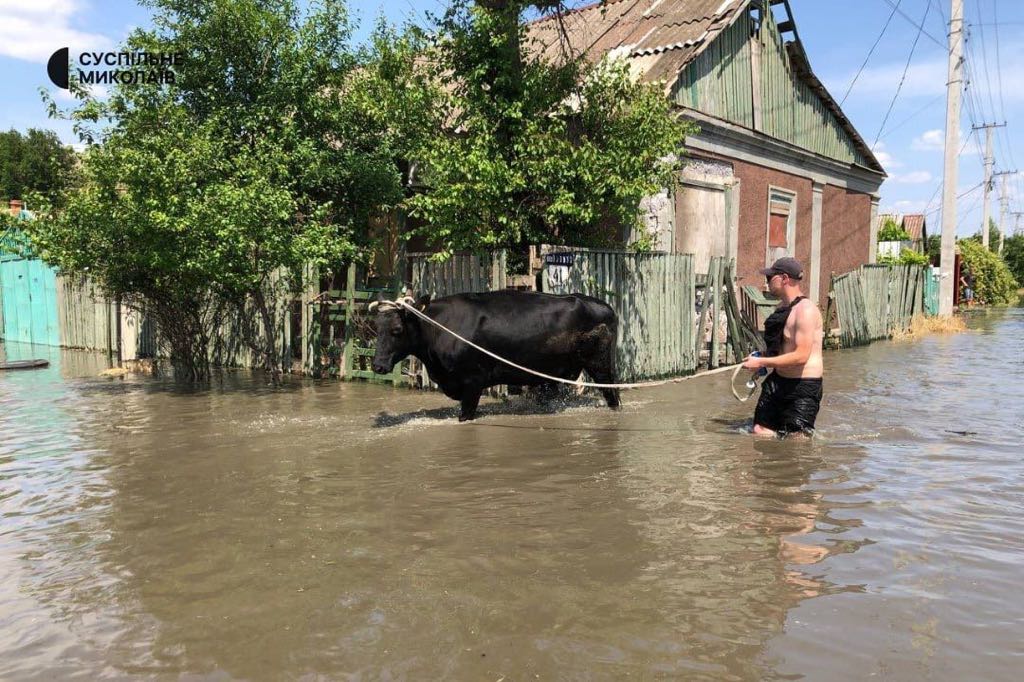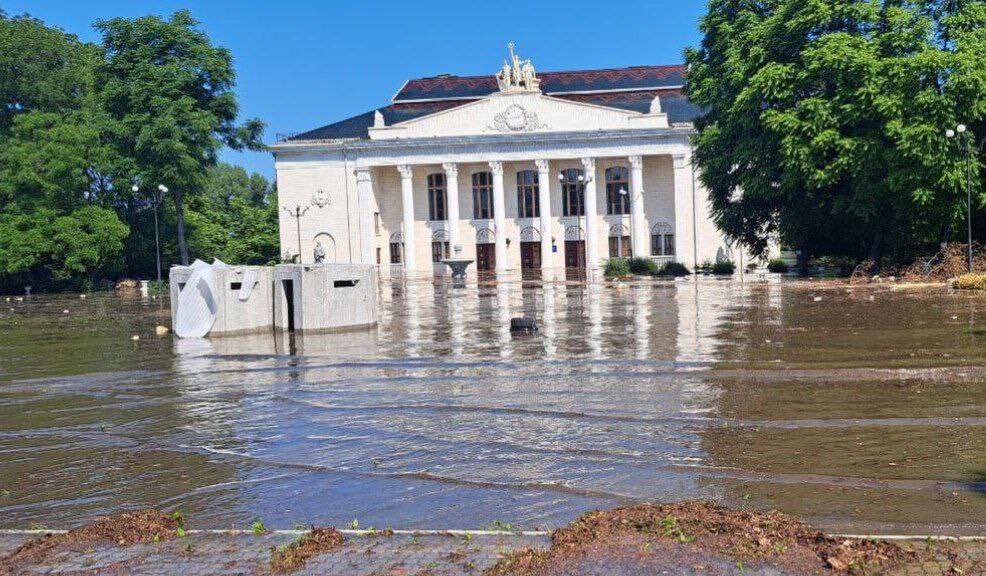As the slow-motion disaster caused by the collapse of the Nova Kakhovka dam continues, Russian officials have repeatedly blamed Kyiv for the crisis. Unusually, however, the Kremlin has not told the country’s propaganda outlets to do the same; in fact, it hasn’t issued any direct instructions for how the events should be covered at all, two sources from major pro-government news agencies told independent Russian news outlet Meduza. As a result, virtually all pro-Kremlin outlets have chosen to downplay the significance of the disaster as well as the scale of the flooding, explains Andrey Pertsev.
by Andrey Pertsev
 Parts of Ukrainian city Kherson have flooded as a result of the collapse of the Kakhovka dam. Image Twitter.
Parts of Ukrainian city Kherson have flooded as a result of the collapse of the Kakhovka dam. Image Twitter.
Russia’s pro-Kremlin media agencies have not received any direct instructions from the Putin administration about how to cover the disaster at the Kakhovka Hydroelectric Power Plant, two sources from major pro-government media outlets told Meduza. (The authorities usually send out “guidelines” for how news outlets should report on major events almost immediately after they occur.)
According to Meduza’s sources, the country’s propaganda outlets have not even been told what they should name as the reason for the dam’s destruction. “We shouldn’t harp on it too much, but we can’t be silent about it either,” one source said, describing the pro-Kremlin media’s overall approach to covering the disaster so far.
State news channels and propaganda Internet media have taken differing approaches in their reporting on the dam breach and its aftermath. In most cases, the country’s top TV networks have not made it the leading story in their news broadcasts.
On June 8, for example, the state-run network Rossiya-1 opened its afternoon news show with a segment about how Russian forces were “successfully repelling” attacks by the Ukrainian military. When it did get around to covering the Nova Kakhovka explosion and its aftermath, it referred to the flooding in the Kherson region as a “flash flood that followed the Ukrainian shelling of the Kakhovka dam.” In the same network’s evening broadcast, the story was covered again, though this time the network described the event as a “barbaric attack” by Ukraine (echoing Vladimir Putin’s remarks earlier in the day) and called the aftermath a “flood.”
 The floods have also reached the neighboring province of Mykolaiv. Image Telegram.
The floods have also reached the neighboring province of Mykolaiv. Image Telegram.
Another news broadcast on Thursday, this one on the major state network Channel One, included the dam explosion as its fourth story. The segment followed reports about an “international forum of education ministers,” another about Western weapons that were purportedly destroyed on the battlefield by Russian troops, and a third story about a “Kyiv regime agent” arrested in Donetsk. In its coverage of the dam explosion, the network referred to the Kakhovka power plant as “attacked” but did not specify who attacked it or how.
All pro-Kremlin outlets (including online ones) that have covered the disaster have focused on how Kherson region occupation authorities successfully evacuated local residents from flooded areas, though this characterization is inaccurate. Meduza has already reported on how Russian officials failed to evacuate residents and how, at least in the initial hours after the explosion, they actually prevented evacuation efforts by others.
According to an employee of a Russian state-run media agency who spoke to Meduza, pro-Kremlin outlets have also told viewers and readers that “Russia is saving and assisting” people while “Ukraine is shelling the people Russia is helping.”
A source close to the Putin administration (which is typically the entity responsible for creating the “guidelines” for how pro-government media should cover major events) told Meduza that “focusing on reasons [for the disaster] would be ill-advised, currently.”
“Officially, the president is pointing to Ukraine; [Defense Minister Sergey] Shoigu has said that Ukraine did it, and [Kremlin spokesman] Dmitry Peskov has said the same thing. That’s enough [to make Moscow's position clear]. And it’s better to emphasize the positive, not least because we don’t want to scare people. It’s a standard working mechanism,” he said, adding that the dam’s destruction was “essentially a natural disaster.”
 The Culture Palace in Nova Kakhovka became one of the first buildings to be flooded. Image Twitter.
The Culture Palace in Nova Kakhovka became one of the first buildings to be flooded. Image Twitter.
The source also said that the disaster at the Kakhovka HPP was an “important event” but “doesn’t stand out” against the backdrop of the war as a whole: “All kinds of things happen in the special military operation zone. For now, the number of deaths isn’t even in the dozens” (the real number of deaths resulting from the disaster is unknown, and some volunteers have said that hundreds of people may have died already in the flooding).
The occupation authorities’ reaction to the disaster appears to confirm that this is indeed Moscow’s view. It took local officials hours to issue an official response to the news of the dam’s destruction, and they initially announced that there was no need for a “large-scale evacuation.” By the evening of June 6, the Moscow-backed authorities reported that a plan to evacuate residents had been made, but that “few” had “expressed a desire to leave.” Meanwhile, people were trying desperately to escape flooding and to rescue their neighbors and relatives (though several Russian state news programs reported that people seen standing on rooftops to escape the flooding had simply refused to evacuate).
Not even Aleksandr Kurenkov, the head of Russia’s Emergency Situations Ministry, traveled to the scene. Instead, he sent his deputy, Anatoly Suprunovsky. (There are reports that Suprunovsky’s subordinates have forbidden volunteers to rescue people stranded in flooded buildings.)
Yet Putin’s deputy chief of staff Sergey Kiriyenko did travel to the occupied territory, as he has done many times since the start of the February 2022 invasion. According to two sources close to the Putin administration, Kiriyenko was required to make the trek in light of his role as the Kremlin’s “Donbas czar”: “That’s his area of responsibility, and in a situation like this, he needs to be on-site.”
Neither the Kremlin nor Kiriyenko has publicly criticized the occupation authorities’ failure to evacuate residents or the deaths of people (and animals) in the Kherson region. Meduza’s source close to the presidential administration said that “on the contact line, an evacuation isn’t going to be possible without a snag or two.”
This article was originally published by Meduza.
